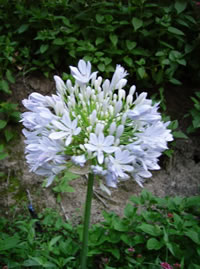How to Grow and Care for a Lily of the Nile
Agapanthus praecox
The Lily of the Nile, or African Lily as it is sometimes called, is a tuberous rooted, clump-forming tender perennial with deep green, arching, strap like leaves.

In mid summer to early fall, they produce rounded, 3" starburst flower heads that consist of up to a hundred small tubular flowers in colors that range from a brilliant blue to pure white on top of stiff 2-3 ft. stems. Agapanthus hybrids have been developed that grow only 18" tall, or up to 5 feet, with flower globes ranging from 1½-6". Agapanthus praecox are hardy in USDA planting zones 9-11.
Planting and Growing a Lily of the Nile Plant
The Lily of the Nile should be grown in well draining soil that has been supplemented with peat moss, compost or well rotted manure. Agapanthus will not survive in soils that are waterlogged!
Plant African Lily tubers 2" deep and 6" apart, in an area where they will receive full sun in the north or light shade in the south. Provide a heavy mulch to help retain moisture and keep the roots cool. Water thoroughly and regularly after planting.
Thick, fleshy roots and new foliage will begin to develop within a few weeks. Keep the soil evenly moist in the spring and summer. Gradually allow the soil to dry out in the fall and keep them nearly dry in the winter.
While actively growing or in bloom feed your Agapanthus plants monthly with a ½ strength solution of a water soluble, 15-30-15 fertilizer.
As with other bulb type plants, when your African Lily has finished blooming, don't cut off the foliage.
Allow it to die back naturally so that the leaves can gather and store nourishment for next year's flower show. In colder winter regions, Lily of the Nile plants should be grown in containers to allow them to be brought indoors for the winter. Keep the container in a cool (35°-45°) place and water sparingly during the winter. As an alternative, Agapanthus can be dug up once the plant goes dormant in the winter. Store the roots in a dry location at 40° - 50° and replant them in the spring.
When they are grown as house plants, Lilies of the Nile should be planted in any good, well draining potting soil and grown in a place where they will receive bright, indirect sunlight.
Make certain that the pot has sufficient drain holes.
Propagating and growing Lily of the Nile plants from seed
Agapanthus plants can be propagated by division in late winter or very early in the spring.
Lily of the Nile plants that are grown from seed will take 3-5 years before they produce their first flowers.
Their seeds can be sown indoors at any time of the year.
Cover the seeds lightly, then maintain a temperature in the growing medium of 75° until germination, which takes 21-35 days.
Lily of the Nile Agapanthus praecox
